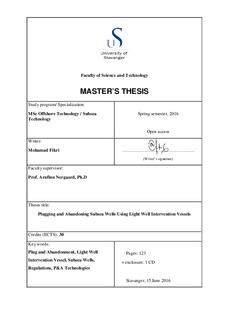| dc.description.abstract | There are thousands of subsea wells in the world. The subsea industry is growing, more and more subsea wells are being developed. When the wells are no longer used, usually because they become unproductive, they need to be permanently plugged and abandoned (P&A). The regulations order the oil and gas industry to seal the unused wells to protect the environment. In the next few years, many of those subsea wells are expected to reach their ‘unproductive phase’, which means there will be a considerable number of subsea wells to be abandoned.
For the last couple of years, lots of investment has been spent in the development of new technologies dedicated to well P&A. However, the current method of P&A operation is still traditionally performed with the same tools that are used for drilling and completions. This expensive way of operation raises up companies’ costs and the time to P&A a well. The market remains dominated by the use of conventional solutions, such as full capacity drilling rigs. This method indeed makes sure the whole operation can be done safely but it is a less cost-effective solution. Furthermore, P&A activity has no value creation. Therefore, alternatives methods are necessary. One of the alternatives is to use a monohull light well intervention (LWI) vessel, which has a significantly lower cost, to replace the rig for the entire P&A operation.
In this thesis, the challenges of performing P&A using LWI vessel are described. Several concepts of solutions are presented, with alternative methods and new technologies that can be used in qualifying LWI vessel P&A operation. There exists a great potential in moving the conventional method from using rig into smaller and cheaper LWI vessel. However, most of the technologies described in this thesis are still in a conceptual stage. Thus, comprehensive qualifications and extensive field trials are needed.
The P&A operation utilizing LWI vessel that is discussed in this thesis can be divided into two methods; riserless and riser based method. Presently, the better option for P&A activity using LWI vessel is to use a riser and utilizing coiled tubing for the operation. Modifications of the vessel with some additional equipment might be needed to satisfy the operational requirements. The riserless operation could become the best option after the technology is qualified through considerable field trials. Therefore, companies’ involvement is now needed to test the new technology and to make concrete steps in order to change the mindset of traditional P&A operation. | nb_NO |
